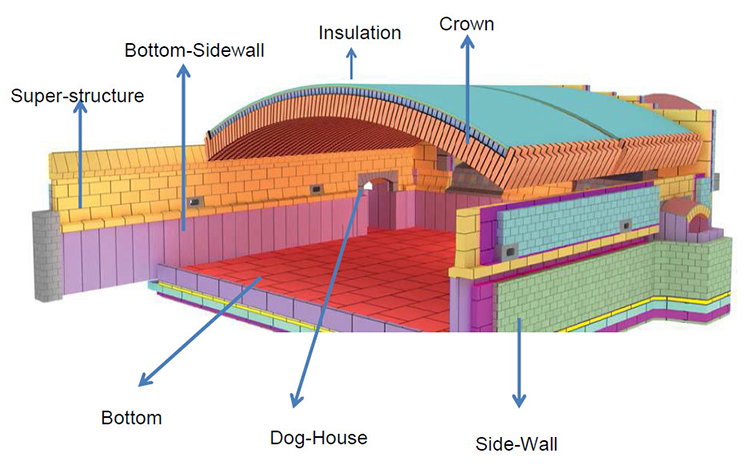Glass Furnace Overview
In the production of glass—taking float glass as an example—there are three major thermal equipment systems: the float glass melting furnace, the float glass tin bath, and the glass annealing lehr. The glass melting furnace plays a crucial role in melting the raw materials into molten glass, followed by clarification, homogenization, and cooling to the forming temperature.
The tin bath is a key component for forming the glass. Molten glass at a temperature of 1050–1100°C flows through the feeder channel and onto the surface of molten tin. On the tin surface, the glass spreads and is polished. Controlled by mechanical traction, edge barriers, and edge stretching machines, the glass ribbon is formed with the desired width and thickness. It gradually cools down to about 600°C before exiting the tin bath.
The purpose of the annealing lehr is to eliminate residual stress and optical non-uniformities from the float glass, while stabilizing the internal structure. The continuous glass ribbon, at around 600°C from the tin bath, passes through the transition rollers into the annealing lehr.

All three of these thermal systems require refractory materials. The stable and efficient operation of glass melting furnaces relies heavily on the support of various refractory products. Below are the 9 commonly used types of refractory materials in glass melting furnaces and their characteristics:
01 Silica Brick for Glass Furnaces
-
Main Component: Silicon dioxide (SiO₂), content above 94%.
-
Working Temperature: Max. 1600–1650°C.
-
Características: Excellent resistance to acidic slag but poor resistance to alkali vapors.
-
Applications: Mainly used in constructing the crown, breast walls, and small furnaces.
02 Fireclay Brick for Glass Furnaces
-
Main Components: Al₂O₃ (30–45%) and SiO₂ (51–66%).
-
Working Temperature: Max. 1350–1500°C.
-
Características: A weakly acidic refractory with good refractoriness, thermal stability, and low thermal conductivity.
-
Applications: Used in the tank bottom, working end, passage walls, regenerator walls, arches, checker bricks, and flue areas.
03 High Alumina Brick for Glass Furnaces
-
Main Components: SiO₂ and Al₂O₃ (Al₂O₃ > 46%).
-
Working Temperature: Max. 1500–1650°C.
-
Características: Good corrosion resistance to both acidic and basic slags.
-
Applications: Widely used in regenerators, working ends, feeder channels, and feeder mechanisms.
04 Mullite Brick
-
Main Component: Approximately 75% Al₂O₃, primarily in mullite crystal form.
-
Density: 2.7–3.2 g/cm³; Porosidade Aparente: 1%–12%.
-
Working Temperature: 1500–1700°C.
-
Applications: Sintered mullite bricks are used for regenerator walls, while fused mullite bricks are applied to tank walls, peepholes, and wall buttresses.
05 Fused Cast AZS Brick (Zirconia Corundum Brick)
-
Also known as White Iron Brick.
-
Grades by ZrO₂ Content: 33%, 36%, and 41%.
-
Typical Composition: Al₂O₃ (50%–70%), ZrO₂ (20%–40%).
-
Density: 3.4–4.0 g/cm³; Porosidade Aparente: 1%–10%.
-
Working Temperature: Up to 1700°C.
-
Applications:
-
33% and 36% grades: Tank walls, breast walls, burner blocks, flat arches, piers, and doghouse crowns.
-
41% grade: Corner areas of tank walls and throat areas where erosion is most severe.
-
-
This is the most widely used fused-cast refractory in the glass industry.
06 Fused Alumina Brick
-
Includes fused α-β and β-alumina bricks.
-
Main Component: 92%–94% Al₂O₃ in corundum crystalline form.
-
Density: 2.9–3.05 g/cm³; Porosidade Aparente: 1%–10%.
-
Working Temperature: Around 1700°C.
-
Características: Exceptional resistance to glass penetration with minimal contamination.
-
Applications: Used in tank walls, tank bottoms, feeder channels—anywhere in contact with molten glass requiring zero contamination.
07 Quartz Brick
-
Main Component: SiO₂ ≥ 99%.
-
Density: 1.9–2.0 g/cm³; Refractoriness: 1650°C; Working Temp: ~1600°C.
-
Características: Strong resistance to acidic corrosion.
-
Applications: Used in acidic borosilicate glass furnaces—e.g., tank walls and thermocouple openings in the flame space.
08 Basic Refractory Materials
-
Includes magnesia brick, magnesia-alumina brick, magnesia-chrome brick, and magnesia-olivine brick.
-
Características: Excellent resistance to alkaline materials; Refractoriness: 1900–2000°C.
-
Applications: Widely used in the upper walls and crowns of regenerators, checkers, and structural parts of small furnaces.
09 Insulating Brick for Glass Furnaces
-
Glass melting furnaces have a large heat loss area and low thermal efficiency. To reduce energy consumption, extensive insulation is essential.
-
Applications: Insulating the tank walls, bottoms, crowns, and regenerator areas.
-
Características:
-
High porosity, very lightweight (density ≤ 1.3 g/cm³).
-
Excellent thermal insulation due to air’s poor thermal conductivity.
-
Thermal conductivity is 2–3 times lower than that of conventional refractories.
-
-
Types: Clay insulating bricks, silica insulating bricks, high alumina insulating bricks, etc.
